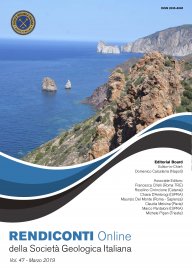
Pollutants transfer from Soil to water: geochemical investigation in different watersheds
Alberto Tazioli (1), Cristiano Casucci (2), Roberto D’Amato (3), Arianna De Bernardi (2) & Elga Monaci (2)
(1) Department of Scienze e Ingegneria della Materia, dell'Ambiente ed Urbanistica, Università Politecnica delle Marche, Via Brecce Bianche Ancona, Italy.
(2) Department of Scienze Agrarie, Alimentari e Ambientali, Università Politecnica delle Marche, Via Brecce Bianche Ancona, Italy.
(3) Department of Agriculture, Food and Environmental Sciences, University of Perugia, via Borgo 20 giugno, 74, Perugia, Italy.
Corresponding author e-mail: a.taziolit@univpm.it
Volume: 47/2019
Pages: 133-140
Abstract
Policies for sustainable management of watersheds and groundwater quality still exist, but decline of water quality is being observed, especially due to the human impact on the environment.
In this study, a comparison between two areas in the Marche region, very different from a geological, pedological and hydrological points of view, has been performed with the objective to identify and study the transfer mechanism of pollutants from the pollution source, through the soil matrix to the surface and ground waters.
The first area is characterized by a high human impact, in terms of agriculture activities, industries and urban settlements; the geology of the area is given by alluvial plains, sands and clays of the Plio-Pleistocene and sandstone of the Pliocene. The second area is more natural, but small crops (as alfalfa and cilantro) are cultivated in certain zones of the watershed. The geology is quite different, with
the outcrops of the Umbria-Marche limestone ridge at the center of the basin.
Periodic sampling of soils, surface water and groundwater were performed in the investigated period, and chemical and isotopic (2H and 18O in water samples) contents were determined in each sample.
All the samples were collected in the spring/summer period, when the crops were in active form.
The results indicated some differences in the two study sites, related to the difference in land use, geology and hydrological behavior. Chemical contents of Nichel were high in both the investigated sites (up to 31 mg/l), also in the more natural one, depending on the mineralization of water by rocks and soils. The isotopes, compared to the isotopic content in precipitation, confirmed the supposed
mechanism of pollutants transfer and helped in the aquifers and rivers recharge identification. Further investigations are in progress in the areas to better detect and validate the proposed mechanism.
Keywords
Get Full Text